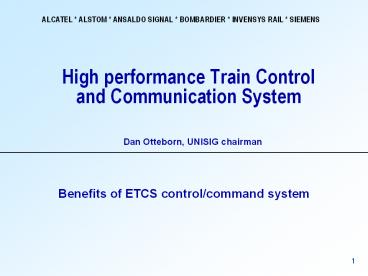High performance Train Control and Communication System - PowerPoint PPT Presentation
1 / 7
Title:
High performance Train Control and Communication System
Description:
High performance Train Control and Communication System Dan Otteborn, UNISIG chairman Benefits of ETCS control/command system Interoperability: A European and global ... – PowerPoint PPT presentation
Number of Views:87
Avg rating:3.0/5.0
Title: High performance Train Control and Communication System
1
High performance Train Control and
Communication System
Dan Otteborn, UNISIG chairman
- Benefits of ETCS control/command system
2
Interoperability A European and global
technical challenge
- In the railway sector Interoperability is
generally understood as trains being able to pass
national boundaries without any technical or
administrative hindrance. Rail transport should
be able to compete with road or air transport on
equal terms concerning boarder passing. - In order to achieve this a number of conditions
have to be fulfilled such as harmonised technical
standards but also harmonised administrative
rules and regulations. - It is also necessary to specify technical
parameters to a level of details enabling
different manufacturers to compete at any time
for any projects. Interoperability thus also
means that products from different supplier must
work together in an interoperability way.
3
Interoperability A European and global
technical challenge
- The very long history of national railway
operation and a closed supplier market have
created a none interoperable European railway
network resting on a huge legacy investment. - Creation of a European interoperable railway
network needs to take this legacy investment into
account, making the interoperability
standardisation a very complex undertaking. - As a matter of facts the real technical problems
and the intellectual difficulties in creating a
new interoperable standards almost entirely comes
from the history. Without the need of taking this
into consideration, practically no technical
problem would have existed with the technology
available for ETCS today.
4
Interoperability A European and global
technical challenge
- As for the existing legacy systems, not only are
they are not interoperable. They are in most
cases coming to the end of their life expectancy
with severe problems on availability, safety,
functionality, component and know-how
obsolescence. - On top of the above constrains it is also
necessary to develop the interoperability
standard in a way that they are open to
incorporation of new technologies and to a
certain extent, new functionality as well. - Today after more than 10 years of work we have a
set of technical specification for
interoperability (TSI) which are demonstrating
interoperability in field operations as well as
in laboratory test to an increasingly degree of
perfections. - For the control command and signalling TSI's we
are now in a face of taking benefits from the
experience gained in pilot projects and CEDEX
laboratory test this will lead to a consolidated
version of the SRS 2.2.2 scheduled for
publication in end of 2005.
5
Interoperability A European and global
technical challenge
- It is commonly accepted that this version will be
sufficient for commercial operations of
interoperable traffic during a number of years. - Simultaneously as the consolidated version of SRS
2.2.2 are being completed work is ongoing in
defining the new baseline SRS 3.0.0. - The work in defining the new baseline is
primarily split into two parts, one resting with
the supply industry and one resting with the IM's
and RU's. The IM's and RU's are responsible for
producing harmonised operational requirements and
the supply industry are responsible of turning
those requirements into technical specifications
and test specification needed for verification.
6
Interoperability A European and global
technical challenge
- It is foreseen that products complying to the new
baseline 3.0.0 are reaching the market in
2009-2010. - The technical challenge we have now in front of
us is to make sure that the interoperability now
achieved is not starting to drift apart.With the
expansion of the European community and the
expansion of the use of the interoperable
products and systems many parties are now
starting to ask for additional functions or
interfaces. - Harmonising operational requirements are
essential in order for manufacturers to specify
and develop interoperable products. - All products being developed as a result of
theTSIs needs to obtain a certificate of
conformity from a Notified Body, all
manufacturers products are therefore equal in
terms of responding to interoperability
requirements specified in the TSI.
7
Interoperability A European and global
technical challenge
- Product differentiation is only possible in areas
outside the TSI specification such as for example
size, (not for the balise) modularity,
achievement of safety and availability targets,
MTBF etc. inside the Black-box is company
specific. - As for all standardised products based on a
stable standard and with free competition, prices
will go down, but as many of the TSI products are
subject to specific site engineering, field
installation, testing, national approval etc. it
is essential to concentrate effort in order to
rationalise cost in this area. This cost is
mostly higher than the actual product cost.































